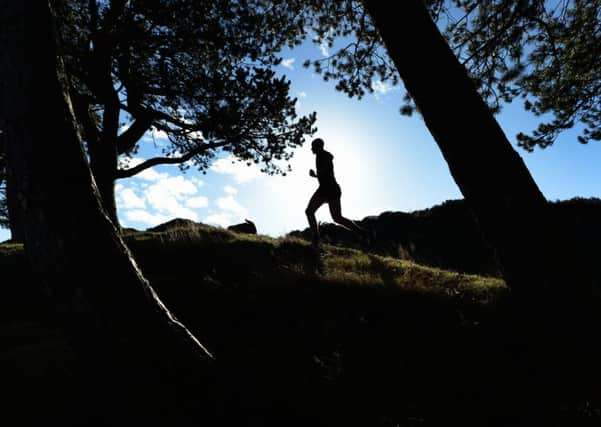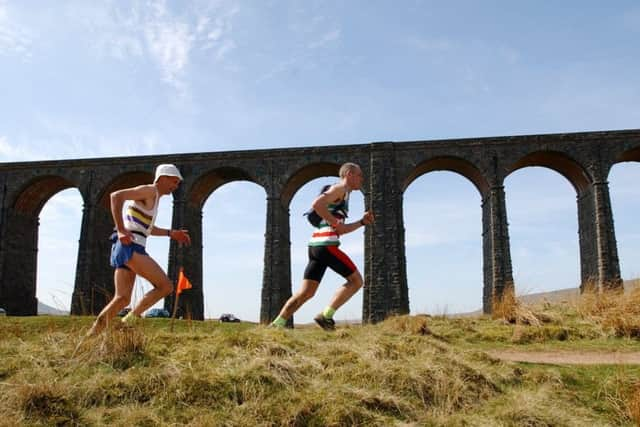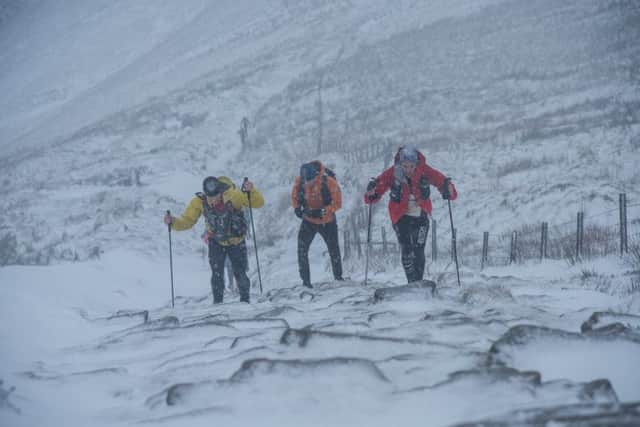Ultramarathons: In it for the long run


Carol Morgan is a little more matter-of-fact about that last stretch, but she still points to the Cheviots as the hardest part of an event that organisers describe as ‘Britain’s most brutal race’.
“Only 27 miles to go and the last lot of hills felt insurmountable,” she says. But surmount it they both did. Carol, an Irish runner now based in Otley, took a massive 43 hours off the ladies’ course record to arrive at Kirk Yetholm in the Scottish Borders in a time of 109 hours and 54 minutes, winning the ladies’ field and coming sixth overall. Tom, born in Micklethwaite and now living in Ilkley, upset the rankings with a late-race surge to win the gents’ category in 99 hours and 26 minutes.
Advertisement
Hide AdAdvertisement
Hide AdRunning ultramarathons (technically any race distance over a marathon, though typically starting at 50km) might sound insane, but the sport has a long tradition and participation is growing.


“Ultrarunning is technically a really old sport,” says Andy Nuttall, editor and publisher of the magazine Ultra. “Starting in the Victorian era with ‘pedestrianism’ – long distance foot races like London to Bath – and then long-running races like the South African Comrades Marathon which started in 1921, and the London to Brighton race which started here in 1951.
“While Comrades has really ballooned in popularity with thousands of runners and live TV coverage, growth in the UK has been more modest. It makes up a tiny subset of running, with somewhere between 25,000 and 30,000 ultrarunners in the UK.”
But it’s growing quickly, to the tune of around 20 per cent each year.
Advertisement
Hide AdAdvertisement
Hide Ad“I think that’s for several reasons,” says Andy. “One is that there’s an innate desire within us to explore, to find new horizons.”


Removing the shackles of expectations about time that abound at shorter distances is appealing to many runners, too.
“So it becomes much more about the adventure, pushing yourself to limits you couldn’t have previously imagined,” says Andy. “And I think that will continue to attract new people, and it can only get more and more popular.”
“I run because I love it,” says Carol, 43, who is a nurse working as an advanced practitioner. “I love the freedom of easy movement, building up a steady easy tempo or challenging myself to push as hard as I can up the hill ahead of me through beautiful countryside. I love the feeling of being totally alone in wild and untamed places, and experiencing nature changing and growing.
Advertisement
Hide AdAdvertisement
Hide Ad“Some days the mountains and the weather beat me back and that’s a gentle, if wet, windy and cold reminder, that really we are not as hard as we think we are. I like ultras because they usually involve being outside in places that are beautiful and remote for long periods of time, challenging myself to keep going, sometimes pushing myself beyond my wildest expectations, questioning my personal and inner strength and resolve, overcoming the demons in my head that tell me I can’t, to achieve that which I never thought that I would.”


Tom, an anaesthetist in his day job, points to 21st century living as a factor, too. “We live in an increasingly urban environment, we live in an increasingly high-pressure environment and running is the most beautiful form of escapism, especially on the fells. If you can get out and clear your head and just keep pushing the boundaries. The ability to go longer, go further, people are just fascinated by it.”
It’s easy to be convinced of the merits of ultrarunning when you listen to runners , but the gap between thought and deed can seem vast.
The backgrounds of even top-level ultra-runners like Tom and Carol are often surprisingly modest.
Advertisement
Hide AdAdvertisement
Hide Ad“I started running when I was approaching 30 and wanted to give up smoking,” says Carol. “So I joined a gym and the training plan had something along the lines of ‘build up slowly to 20 minutes’. I think I managed about two in the beginning. but being tenacious, I gradually got up to 20.


“The distances just got longer and longer after that, the hills got bigger and bigger but the theme of tenaciousness stayed, along with being with friends out running.”
Tom came to the sport from a different angle.
“I had no interest in running whatsoever until probably around 10 years ago,” he says. “I quite liked walking in the hills, liked being outdoors. And then once the kids were born there wasn’t enough time to get out for long walks. So I started taking a bit of time to run up on the moors, see the view and then run back down again.
“I never entered any races. Wouldn’t have called myself a runner, wouldn’t have called myself a fell runner because to me fell runners were insane people who were insanely fit.”
Advertisement
Hide AdAdvertisement
Hide AdBut he took part in a charity walk around the Yorkshire Three Peaks and decided to run it. He completed it in four and a half hours, a time which would put him halfway down the field in the annual Three Peaks fell race. “So maybe I could call myself a proper fellrunner.”
That lack of elitism carries through to Carol and Tom’s approaches to the Spine. “I had no idea if I had the ability to finish the race, never mind beat any records. My first and most important goal was to finish,” says Carol.
Tom insists that he was working purely towards his personal goal of finishing in under 100 hours right up until the point he overtook previous leaders Pavel Paloncy and Eugeni Roselló Sole.
While running 268 miles sounds like a superhuman feat, Tom insists that it’s more accessible than people think. “Ultra-running is totally about mind over matter. I totally believe that anyone could do a 100-mile event.
Advertisement
Hide AdAdvertisement
Hide Ad“So long as you can get fit enough that you can keep moving and eating, anyone can do it depending on the timescale. But you’ve got to have the mind over matter mindset.”
The strong community around the sport helps. Friends also come up frequently when Carol discusses her race highlights, be they fellow racers or friends and family who offer support.
Carol wants to encourage more women. “The nurturing of misrepresentation of girls and women in sport starts at home, school, work and wider society where looking good, having the right size breasts and wearing the right clothes is valued over being strong, powerful, skilful and competitive. The characteristics needed to be good at sports are not fostered at home and in our society for females, but they are for men.”
“If you look at women who’ve excelled in running, either road or off, they tend to be people who don’t take no for an answer.
Advertisement
Hide AdAdvertisement
Hide Ad“This characteristic will not only demonstrate itself while running and (often) beating (lots of the) men, but will also be there when they are discouraged from entering male arenas in other aspects of their lives, like employment, studying, etc…
“They’ve not only questioned the status quo about society’s expectations of them, but also their own.”
But, still, the physical steps towards running an ultramarathon are simple. “The vast majority of ultrarunners I know generally have a very similar ethos to me,” says Tom. “They’ll get out when they can for as long as they can in the hills and just try and enjoy the views.”
Carol puts it simply. “The preparation for this event started years ago on a treadmill in a gym, doing run one minute, walk one minute. It’s just been a very slow gradual build up to stuff this big, with lots of other lovely challenges along the way.”
• Upcoming Yorkshire ultramarathons include the Pennine Barrier Ultra on June 17, the Hardmoors series running throughout the year and the 30, 60 or 100-mile White Rose Ultra on November 4.